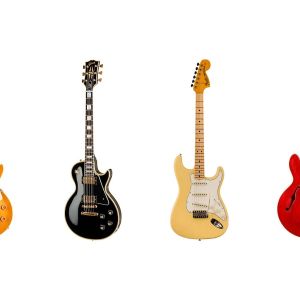When you buy through our links, we may earn an affiliate commission.
The Gibson Explorer is hands-down one of the all-time coolest guitar body styles ever invented.
Since its debut in 1958, Explorer-style guitars have been synonymous with boldness in design and sound. While the Gibson original set the standard, many guitar manufacturers now make their own take on this iconic design.
Fortunately, we’ve embarked on a mission to seek out the best of these iconic guitars. In this comprehensive review, we’ll dive deep into the world of explorer-style guitars. Our top pick, the Gibson ’70s Explorer, is an excellent, modern example of the original Explorer body style.
Stay tuned as we delve into the distinct features, benefits, and sheer rock ‘n’ roll charisma of these legendary axes, arming you with the knowledge to pick the perfect match for your adventurous musical soul. Not a fan of the Explorer fan? Read our picks for Strat style guitars.
Quick Summary of the Best Explorer Style Guitars
- Gibson ’70s Explorer Electric Guitar (Best Overall)
- Epiphone Explorer “Inspired By Gibson” Electric Guitar (Best Epiphone)
- Gibson Custom Explorer Custom (Best Premium)
- Schecter E-1 FR S Special Edition Electric Guitar (Best Explorer Style Guitar With Floyd Rose)
- Jackson Kelly JS32T (Budget Pick)
- Dean Z 79 Electric Guitar (A Great Alternative)
Best Explorer Style Guitars
1. Best Overall – Gibson ’70s Explorer Electric Guitar
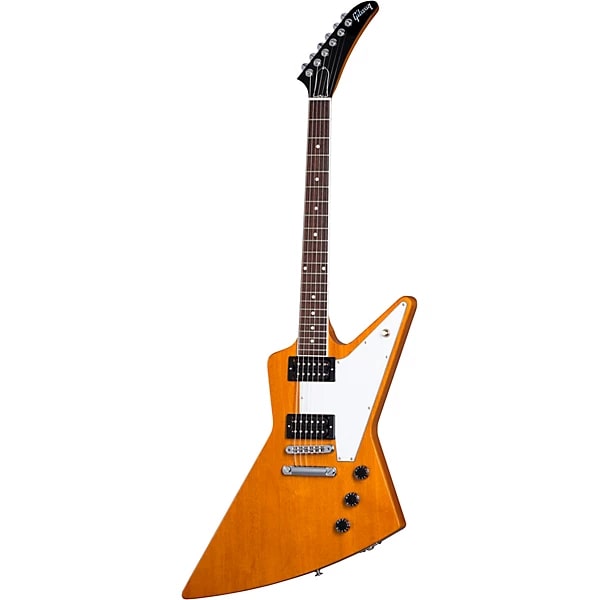
SPECS
- Body: Mahogany.
- Neck and fretboard: Mahogany neck with a rosewood fretboard.
- Pickups: 2 Gibson 70’s Tribute humbuckers.
This guitar boasts many features in common with the original Gibson Explorer, including a nitro finish, Orange Drop capacitors, and 1970s tribute humbuckers. Craftsmanship shines through with premium tonewoods, a Slim Taper neck, and a 22-fret rosewood fingerboard that spans a 24.75-inch scale.
The ’70s Explorer is grounded Gibson history, especially in its selection of tonewoods. The mahogany body and neck resonate with a balanced tone, reminiscent of the African Limba (or “korina”) used in the original Explorer.
This wood choice offers a robust sound, characterized by rich mids and harmonics, while the rosewood fingerboard adds clarity without sacrificing warmth.
But the real magic lies in the guitar’s electronics. Gibson’s ’70s Tribute pickups deliver a powerful output designed for overdrive, with wax potting to prevent unwanted feedback. The result is a rich sound that can handle various musical styles, especially heavier genres.
2. Best Epiphone – Epiphone Explorer “Inspired By Gibson” Electric Guitar
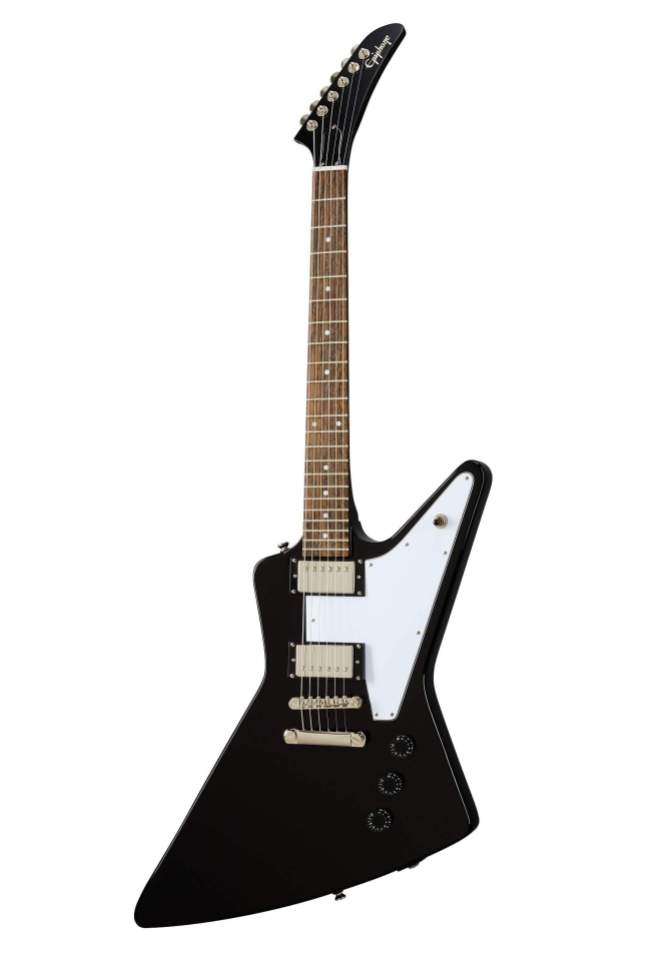
SPECS
- Body: Mahogany.
- Neck and fretboard: Mahogany neck with an Indian laurel fretboard.
- Pickups: Probucker 2 and 3 humbuckers.
Alongside the Flying V, the Explorer was a sight to behold upon its initial release. These guitars felt otherworldly, shattering traditional guitar design norms.
Epiphone’s rendition of the Explorer captures this audacious style in its own right with its mahogany body, SlimTaper neck, and Indian laurel fingerboard.
The Epiphone Explorer is also a marvel of tuning stability with its Grover Mini 18:1-ratio tuners and the LockTone Tune-o-matic bridge. Its ProBucker humbuckers echo the warmth of the Gibson vintage PAF humbuckers with their use of Alnico II magnets.
If you are interested in checking out more Explorer-type guitars but don’t want to put down a lot of money for a Gibson, this Epiphone Explorer is definitely worth checking out!
3. Best Premium – Gibson Custom Explorer Custom
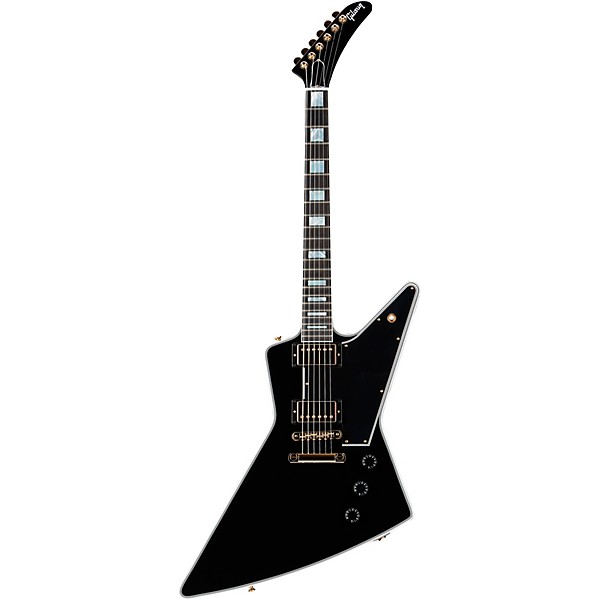
SPECS
- Body: Mahogany.
- Neck and fretboard: Ebony neck with ebony fretboard.
- Pickups: Probucker 2 and 3 humbuckers.
The Gibson Custom Explorer Custom is the essence of rock guitar, just dripping with iconic style and top-notch quality. This iteration from the Gibson Custom Shop provides a few updates on the classic Explorer body shape, including an elegant ebony finish and a matching ebony fretboard.
Stunning visuals aside, Gibson pulled out all the stops, outfitting the Explorer Custom with all premium appointments. With its CTS control pots, Switchcraft toggle switch, and meticulously hand-wired harness, this axe is built to last.
The 490R and 498T humbuckers channel the quintessential Gibson sound but with an extra edge. These pickups draw inspiration from Gibson’s renowned ’57 Classic but with an enhanced upper midrange presence. The result is the signature rich Gibson timbre with an additional punch, so your sound is just as bold as your look.
Plus, the 498T pickup is perfect for rock lead playing. Alnico V magnets provide a boosted output., while the 490R pickup at the neck position is defined by its silky-smooth response, courtesy of Alnico II magnets.
Read about other Gibson Alternatives here
4. Best Explorer Style Guitar With Floyd Rose – Schecter E-1 FR S Special Edition Electric Guitar

SPECS
- Body: Mahogany body with quilted maple top.
- Neck and fretboard: Mahogany neck with ebony fretboard.
- Pickups: 1 x Sustainiac Pickup (neck), 1 x Schecter USA Apocalypse VI Humbucker (bridge)
The Schecter E-1 FR S Special Edition is an Explorer-style guitar that's perfect for high-octane performances. Boasting an array of premium tonewoods (mahogany, maple, and ebony), attractive finishes, and innovative pickup tech, this axe is shred-ready, thanks in no small part to its inclusion of a Floyd Rose bridge.
The Sustainiac pickup in the neck position brings tons of sustain across its three modes. This innovative pickup is engineered with a unique circuit that facilitates seemingly infinite sustain, which is bound to power your solos to the next level.
The Apocalypse humbucker delivers a blend of power and precision. With its alnico magnets, you get a dynamic, rich sound, which is then further sharpened by ceramic magnets for crisp articulation. This perfect storm of sound provides incredible harmonics, allowing you to explore your way into far-out sonic territory.
Rounding off the Schecter E-1 FR S Special Edition’s features is the Floyd Rose 1500 Series tremolo bridge. Reminiscent of the original Floyd Rose design, this bridge ensures pitch-perfect stability, allowing players to dive deep into expressive vibratos and dive-bombs without any tuning concerns.
5. Budget Pick – Jackson Kelly JS32T
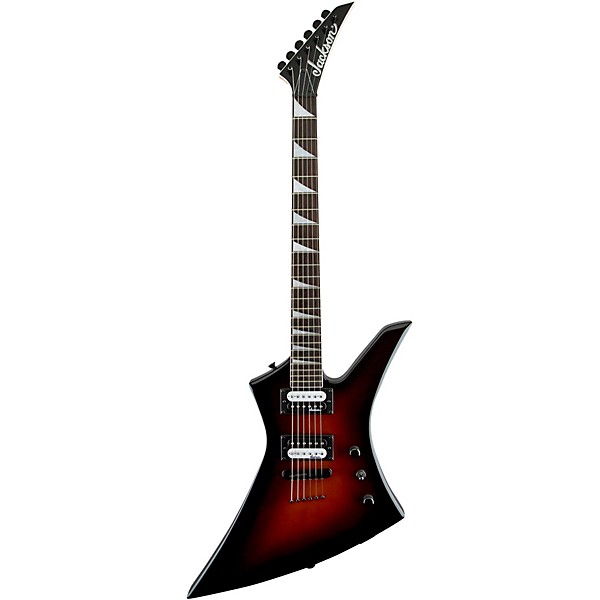
SPECS
- Body: Poplar.
- Neck and fretboard: Maple neck with amaranth fretboard.
- Pickups: 2 Jackson High-output humbuckers.
The Jackson Guitars JS32T Kelly electric guitar offers remarkable value without compromising quality. This instrument boasts dual high-output ceramic-magnet humbuckers that deliver a powerful and expansive tone, perfectly tailored for metal players.
Even at its affordable price point, the playability of the JS32T Kelly stands out. The unique compound-radius fretboard facilitates easy maneuvering around its graphite-reinforced maple neck. Whether you’re a budding rocker or searching for a cost-effective guitar for shredding, the Jackson JS32T Kelly won’t disappoint.
The JS32T Kelly features an amaranth fingerboard with a compound radius and jumbo frets, blending playability and speed. The 12-inch radius at the lower frets ensures comfort for chord progressions, while the flatter 16-inch radius towards the top allows for swift lead play and substantial bends without any fret interference.
Jackson’s custom humbuckers provide the guitar with a robust and sharp tone, making it great for heavy metal and beyond. Plus, with its bold body shape, iconic pointy headstock, and signature shark fin inlays, you'll exude ferocity onstage. With the JS32T Kelly, you get a guitar that sounds fierce and looks the part, too.
6. A Great Alternative – Dean Z 79 Electric Guitar
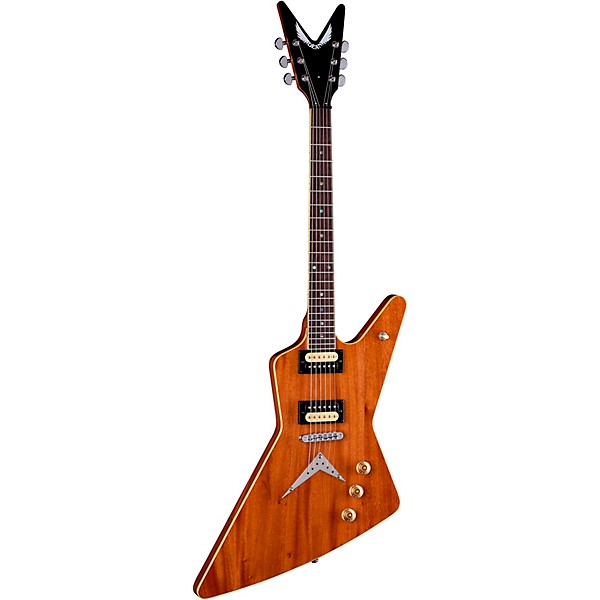
SPECS
- Body: Eastern mahogany.
- Neck and fretboard: Eastern mahogany neck with Indian rosewood fretboard.
- Pickups: 2 DMT Series Time Capsule humbuckers.
Since its introduction in 1977, the Z has been an integral part of the Dean guitars lineup, consistently staying true to its origins. The Z 79 is a testament to that legacy. Crafted with an eastern Mahogany body and a set neck design, it delivers warm tones and remarkable sustain that suit various musical styles.
Equipped with DMT Series Time Capsule pickups, the Z 79 revives the vintage soundscapes of the past while seamlessly adapting to contemporary musical demands. Its aesthetic appeal is enhanced by a rich natural mahogany finish, a beautifully bound body, and Indian Rosewood Fingerboard.
Best of all, this blend of vintage charm and modern playability is available at a price point that offers incredible value.
Looking to up your guitar game? Check out these intermediate guitars here.
Best Explorer Style Guitars Buyer's Guide
When shopping for the best Explorer-style guitars, you should consider the following four factors:
- Tonewood and Construction
- Pickups and Electronics
- Playability
- Hardware and Reliability
Tonewood and Construction
Tonewood is a primary factor that influences a guitar’s sound. Different woods produce distinct tonal qualities.
For instance, mahogany, a common choice for many Explorer-style guitars, is known for its warmth and resonance, producing rich midrange character and deep lows. On the other hand, Maple offers clarity and a pronounced high end, while alder provides a balanced tone.
Beyond the functional aspects, the choice of tonewood and the craftsmanship in its finishing influence the guitar’s visual appeal. The grain patterns, the depth of color, and the texture of the wood all contribute to the guitar’s overall aesthetic. A beautifully crafted guitar can inspire pride and a deeper connection between the instrument and its player.
Pickups and Electronics
The choice of pickups profoundly impacts the guitar’s tonal qualities. Explorer-style guitars often come equipped with humbucking pickups, known for their noise reduction and powerful, warm tone.
However, a wide range of humbuckers are available, each with unique characteristics. For example, vintage-style humbuckers like Gibson ’57 Classics offer a warm, smooth sound, while high-output humbuckers deliver more aggressive, distortion-friendly tones.
The versatility of your guitar depends mainly on the electronics configuration. Many Explorer-style guitars feature multiple pickups, typically one neck pickup and one bridge pickup. A 3-way pickup selector switch allows you to toggle between these pickups or combine them for various sonic textures.
Furthermore, some guitars feature coil-splitting options, transforming humbuckers into single-coil pickups. This provides a broader tonal palette, as single coils deliver a brighter, crisper sound compared to the warmth of humbuckers.
The electronic components also influence how the guitar responds to your playing technique. For instance, the pickup’s sensitivity to nuances in your playing, such as dynamic changes and picking style, plays a significant role in expressiveness. Higher-quality pickups and electronics ensure that your guitar faithfully translates your playing nuances into the amplified sound.
Playability
Selecting the ideal Explorer-style guitar goes beyond aesthetics and tone. Factors like the guitar’s neck profile, weight distribution, and body contours affect how the guitar feels against the body and in the hands. An Explorer-style guitar, with its distinctive shape, should be balanced and ergonomically designed, allowing players to comfortably play for extended periods.
The neck’s design—its width, thickness, and the shape of its back—significantly affects playability. A well-designed neck should allow the player’s hand to navigate seamlessly across the fretboard, facilitating everything from chordal work to rapid solos. The choice between a thin, flat neck and a thicker, rounder one depends on the player’s preference and playing style.
Playability extends across the length of the neck. Notes should ring out clearly, regardless of whether they are played near the headstock or at the higher frets near the guitar’s body. This uniformity ensures that players can utilize the entire range of the instrument without any dead spots or inconsistencies.
Good playability means the guitar is versatile and can handle a range of techniques—from fingerpicking to tapping, from deep bends to sweep picking. Explorer-style guitars, often favored by rock and metal players, should cater to the demanding techniques of these genres.
Hardware and Reliability
If you invest in one of these fantastic Explorer guitars, you want to ensure the hardware is up to par and the guitar will work reliably for many years. Many factors go into determining a guitar’s reliability.
The tuning pegs or machine heads are fundamental to a guitar’s ability to stay in tune. High-quality tuners allow for precise tuning and ensure the guitar maintains its pitch even through vigorous playing, bends, and string attacks.
This is especially crucial in Explorer-style guitars, often used for aggressive rock and metal genres that demand consistent tonal stability.
The type and quality of the bridge and tailpiece determine string spacing, action height, and intonation. An adjustable bridge ensures that the guitar can be perfectly intonated across the fretboard, ensuring that chords and notes sound in tune regardless of where they’re played.
Additionally, some players may prefer a guitar with a tremolo system, which necessitates robust and reliable bridge hardware to handle dive bombs and vibratos without going out of tune.
Faulty or low-quality electronics can lead to crackles, signal loss, or inconsistent volume and tone adjustments. Reliable electronics ensure the guitar’s tone is conveyed cleanly and consistently, without unwanted noise or interruptions.
Guitar hardware, especially if made from inferior materials, can corrode, wear out, or break over time. Premium hardware components are designed for durability, ensuring they can withstand the rigors of regular play, touring, and varying environmental conditions.
This durability translates to fewer replacements and repairs over the guitar’s lifespan.
While often overlooked, hardware components can also impact a guitar’s tone. For instance, a denser, high-mass bridge can add sustain and improve resonance. The choice between different materials for nuts and saddles (e.g., bone, graphite, brass) can subtly influence string vibration and tonal qualities.
Frequently Asked Questions (FAQs)
Are Explorer-style guitars suitable for beginners?
While the unique shape might appeal to many, its size and design might not be comfortable for everyone, especially younger players. However, with the right setup, it can be as suitable for beginners as any other guitar style.
How does the Explorer compare in terms of weight and balance to other popular guitar shapes?
Explorer-style guitars are well-balanced when strapped on despite their unconventional shape. However, they might feel a bit cumbersome to some players when played sitting down.
What kind of music genres is the Explorer-style guitar best suited for?
While many associate the Explorer with rock and metal due to its aggressive appearance and prominent users, its tonal capabilities make it versatile enough for various genres, including blues, jazz, and country.
How does the Explorer-style guitar’s headstock design affect tuning stability?
The straight-pull design of the Explorer’s headstock, where the strings run straight from the nut to the tuning pegs without angling, can enhance tuning stability.
Who are some famous musicians known for using Explorer-style guitars?
- James Hetfield (Metallica)
- The Edge (U2)
- Allen Collins (Lynyrd Skynyrd)
- Matthias Jabs (Scorpions)
- Bill Kelliher (Mastodon)
- Gary Moore
- Brendon Small (Metalocalypse)
- Claudio Sanchez (Coheed and Cambria)
- Dave Grohl (Foo Fighters)
Conclusion
Few guitar body styles are as iconic and captivating as the Gibson Explorer. Its bold design and aggressive sound have made it a go-to choice for musicians across genres, particularly hard rock and metal.
Thanks to this legendary influence, tons of guitar manufacturers have tried their hand in the realm of Explorer-style guitars.
Whether you’re drawn to the classic lines of our top pick, Gibson’s ’70s Explorer, or the variations from Epiphone, Jackson, Schecter, or Dean, you can rest assured that there’s an Explorer-style guitar that suits your playing style and preferences.
Ultimately, the best Explorer-style guitar for you will resonate not only with your musical aspirations but also with your artistic expression. It will be an instrument that feels right, sounds superb, and stands the test of time. Rock on!
